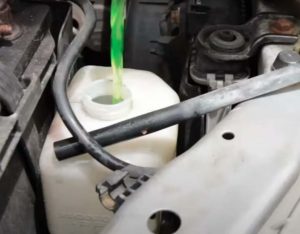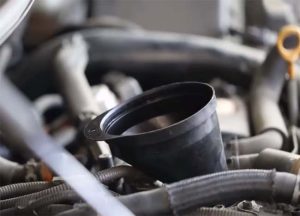This article explores the symptoms drivers may notice if their vehicle has low engine coolant levels, the potential causes, how to safely check the coolant, topping it up when low, and when to seek auto service.
Engine coolant, also called antifreeze, is a specially formulated liquid circulating through passages in your vehicle’s engine block and radiator. It serves the vital roles of transferring heat away from the engine while preventing freezing in cold temperatures and corrosion inside the cooling system. Most modern cars use a 50/50 premixed blend of ethylene glycol antifreeze and distilled water to optimize heat absorption properties. Maintaining this coolant at proper “full” levels is essential for avoiding overheating issues.
Common Causes of Low Coolant
There are a few common reasons you may end up with lowered coolant amounts in your radiator or reserve tank:
-
Leaking Hoses: Cracked, loose, or worn radiator hoses can leak substantial amounts of coolant over time. The same applies for bad water pump seals and housing cracks.
-
Internal Leak: A developing leak somewhere internally in the engine block or head gaskets allows coolant to mix with oil in the crankcase. This consumes antifreeze with no external drips.
-
Overflow Reservoir Failure: Clogs in the radiator cap release valve or cracks in the plastic reservoir tank itself causes coolant overflow. This boils over and evaporates when hot.
Monitoring your engine temperature gauge for early warning signs allows you to address dropping coolant levels promptly before greater harm occurs.
Symptoms and Warning Signs
 Drivers may notice a few warning symptoms if their vehicle has low amounts of engine coolant. Overheating engine is one symptom, as soon as the cooling system drops enough to reduce heat transfer, engine operating temperature begins rising significantly above the normal range around 195-220°F. This is the most serious and noticeable consequence. Another symptom is coolant odor – sweet-smelling steam with an antifreeze odor emanating from the hood and grille area signals a major internal or external leak rapidly depleting coolant reserves. Drivers may also notice the check engine light illuminating on the dashboard.
Drivers may notice a few warning symptoms if their vehicle has low amounts of engine coolant. Overheating engine is one symptom, as soon as the cooling system drops enough to reduce heat transfer, engine operating temperature begins rising significantly above the normal range around 195-220°F. This is the most serious and noticeable consequence. Another symptom is coolant odor – sweet-smelling steam with an antifreeze odor emanating from the hood and grille area signals a major internal or external leak rapidly depleting coolant reserves. Drivers may also notice the check engine light illuminating on the dashboard.
Error codes triggered by abnormal running temperature or emissions control sensor readings due to overheating issues will cause this warning. Persistent knocking, pinging or rattling sounds from the engine compartment often accompany rising temperatures due to low coolant situations as well. This indicates the early stages of heat damage to cylinders and valves. Ignoring these symptoms risks causing extensive and expensive engine repairs down the road. Monitoring coolant condition is vital.
Dangers of Driving with Low Coolant
Allowing your engine to operate while low on coolant presents immediate risks of catastrophic overheating damage the longer it goes unchecked:
-
Cylinder Warping: Abnormally high heat causes aluminum engine blocks to dangerously expand and warp cylinder wall shape. This allows coolant and combustion gas leaks past seals leading to erosion corrosion and oil fouling issues over time.
-
Cracking Heads: Extreme localized heat from depleted coolant softens aluminum cylinder heads to the point major cracks in the casting develop. This necessitates urgent replacement to prevent ruining the engine.
-
Bearing Failure: Excessive crankshaft and connecting rod bearing temperatures lead to premature fatigue wear, wiping, and failure. This requires monumentally expensive engine overhaul and rebuilding.
Monitoring coolant condition and avoiding driving once overheating starts helps contain damage, but the only true fix involves identifying and repairing the source of leaking coolant immediately.
Topping Up Low Coolant
Locating the source of leaks is key, but refilling depleted coolant requires using the same OAT (organic acid technology) formula premix from your last service. Mix thoroughly a 50/50 ratio of antifreeze concentrate with distilled or deionized water, avoiding using hard tap water which causes corrosion. Carefully pour your premixed coolant into the overflow reservoir tank until it reaches the “Full Cold” line. This allows trapped air purging through normal engine operation. Squeezing the upper radiator hose while running helps force out any stubborn air bubbles after adding new premixed coolant. Minor seepage may seal on its own with chemical deposits. But any substantial losses beyond evaporation should be addressed before resuming normal driving. As outlined in our related article, installing a Best Cold Air Intake for Acura models also aids engine cooling efficiency.
When to Call a Mechanic
 While you can safely refill small short-term coolant losses yourself using proper OEM fluid, chronic low levels or overheating episodes should be examined by your trusted mechanic. Diagnostic cooling system pressure tests check for internal leaks where coolant mixes unseen with engine oil. Chemical flushing can dissolve oil fouling plugging passageways. Mechanics also use flow meters inserted in the hoses to measure coolant pump impeller performance, as weak circulation hampers adequate engine heat absorption.
While you can safely refill small short-term coolant losses yourself using proper OEM fluid, chronic low levels or overheating episodes should be examined by your trusted mechanic. Diagnostic cooling system pressure tests check for internal leaks where coolant mixes unseen with engine oil. Chemical flushing can dissolve oil fouling plugging passageways. Mechanics also use flow meters inserted in the hoses to measure coolant pump impeller performance, as weak circulation hampers adequate engine heat absorption.
Additionally, junk yard parts often feature defective radiator caps unable to hold rated pressure levels leading to overflow drains. Precision testing checks radiator cap seal integrity. Seeking professional service helps accurately determine if chronic low coolant stems from simple external weep spots or more serious mixing leaks requiring cylinder head gasket replacement or engine removal to fully rectify.
Conclusion
Neglecting dropping coolant levels risks causing extensive catastrophic overheating and erosion corrosion damage internally within your engine. Monitoring for symptoms like rising temperature gauges, sweet antifreeze odors from underhood steam, and check engine lights allows motorists to address problems in a timely manner. Safely inspecting and topping up reservoirs can temporarily alleviate depletions. But seeking qualified mechanical service should always follow when larger or chronic losses signal wear and leakage issues needing comprehensive repairs. Maintaining adequate coolant remains essential to engine longevity.


Add Comment